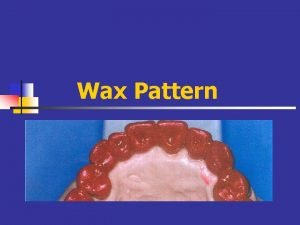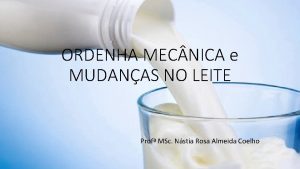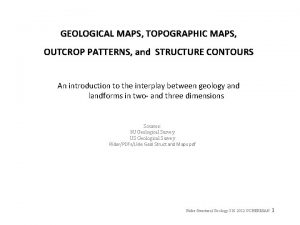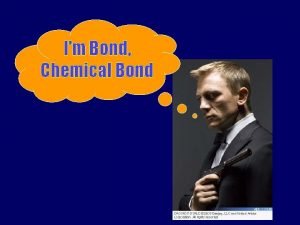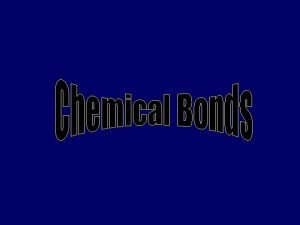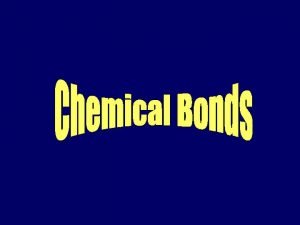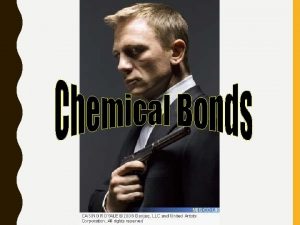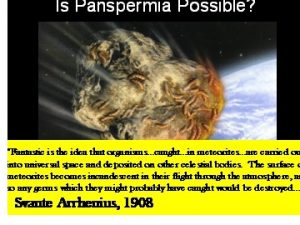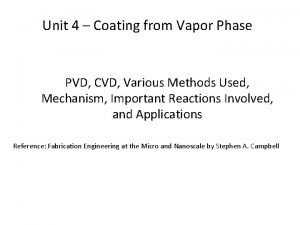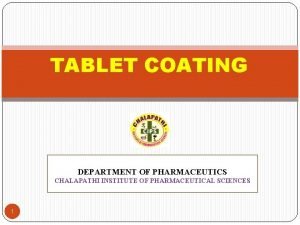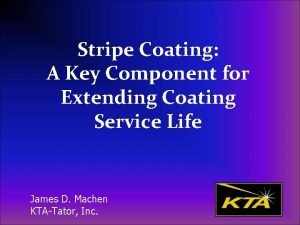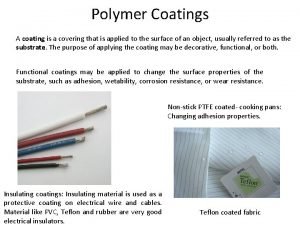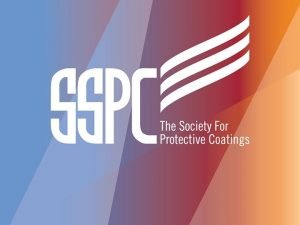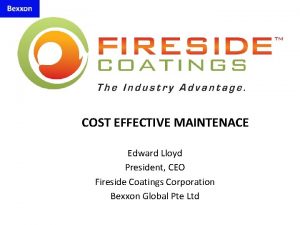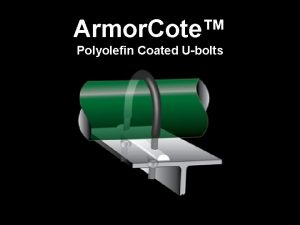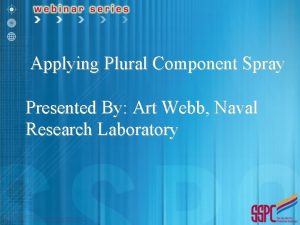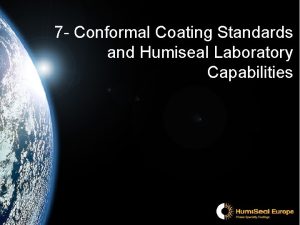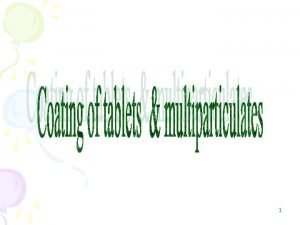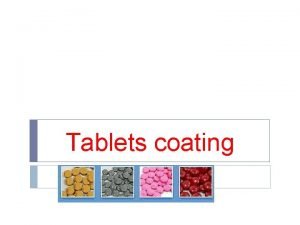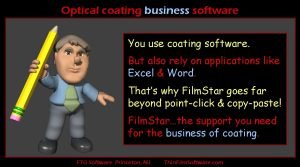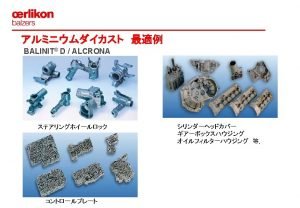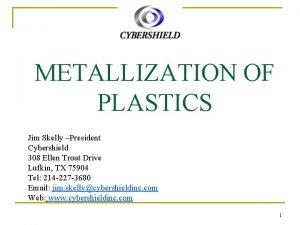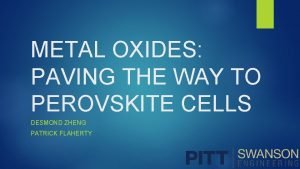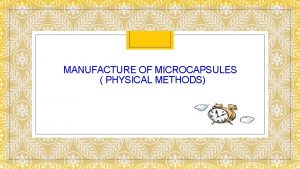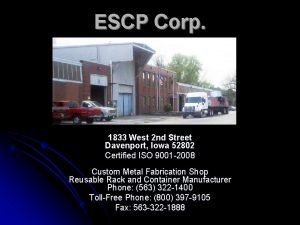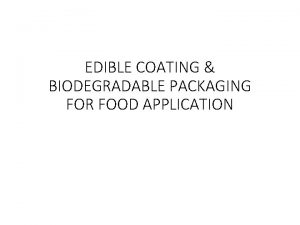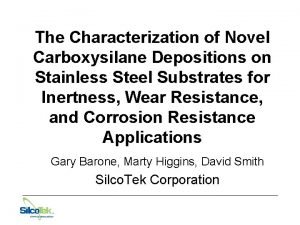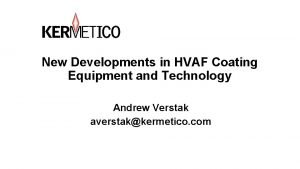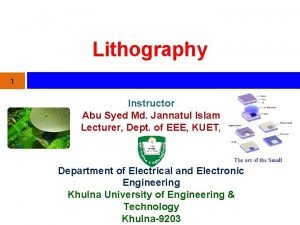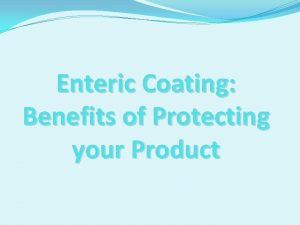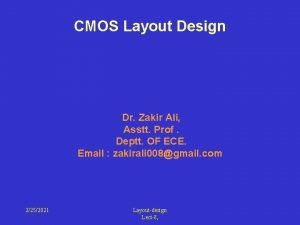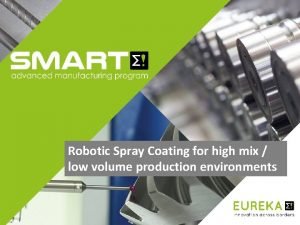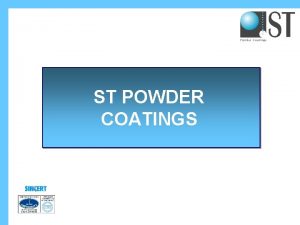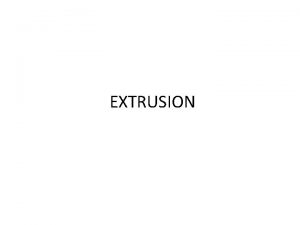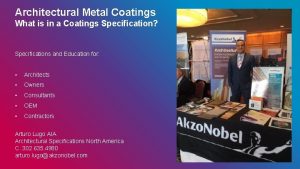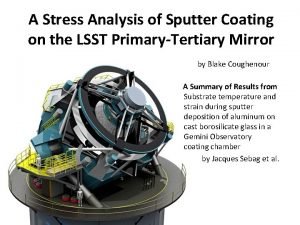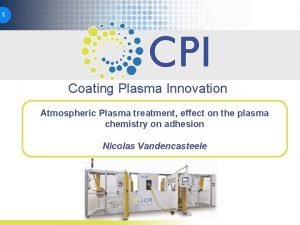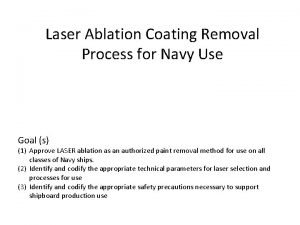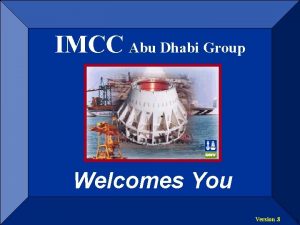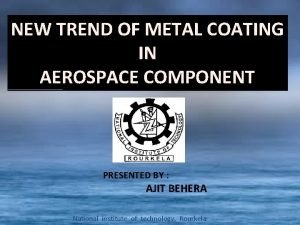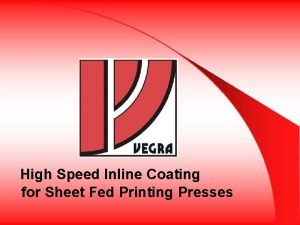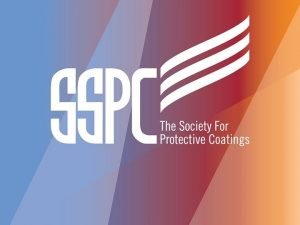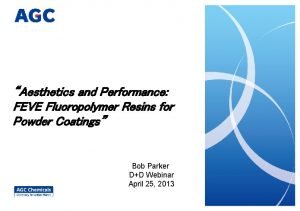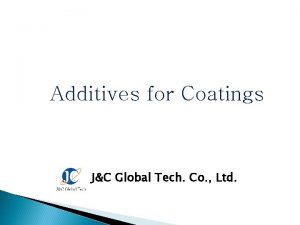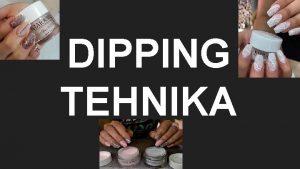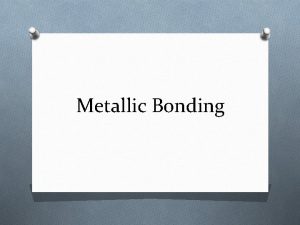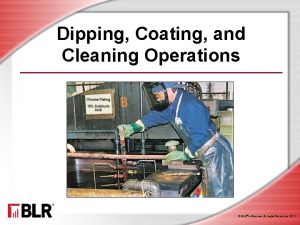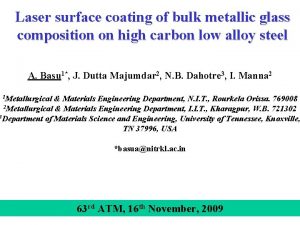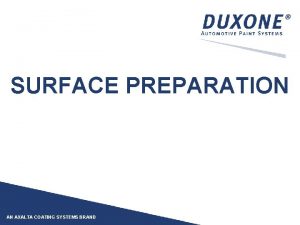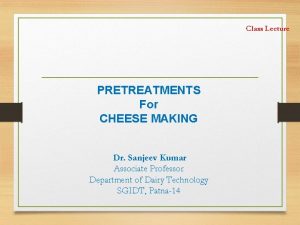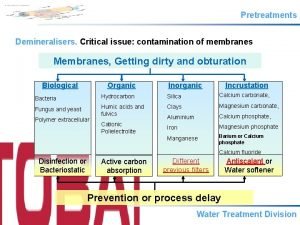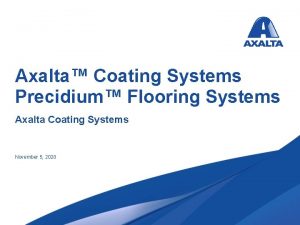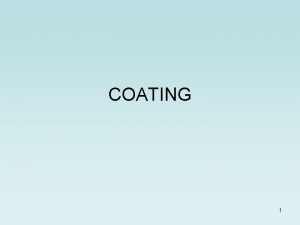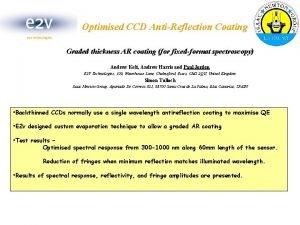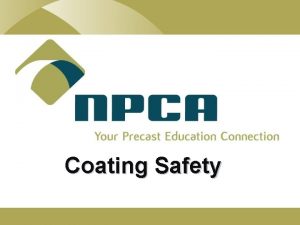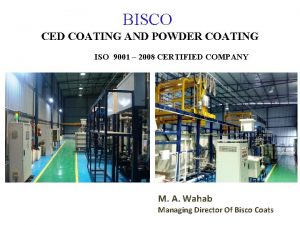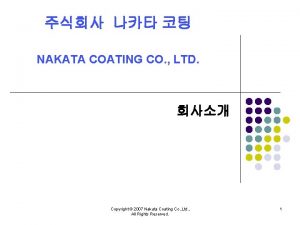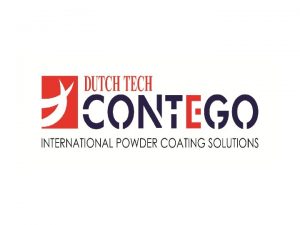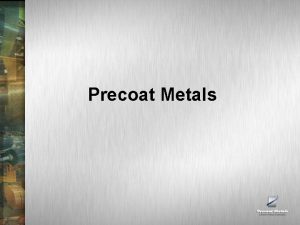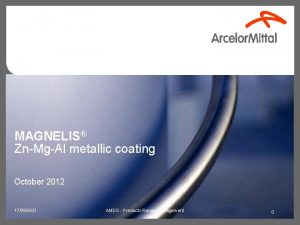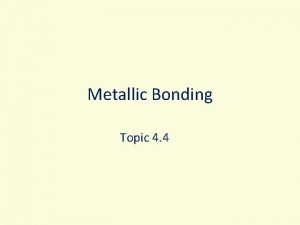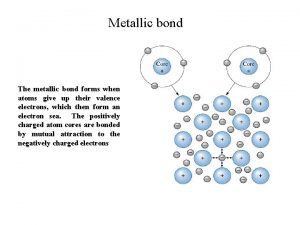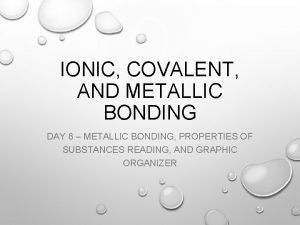Unit 3 Metallic Coating Surface pretreatments Hot dipping
























































- Slides: 56

Unit 3 – Metallic Coating Surface pretreatments, Hot dipping, Galvanizing, Electrolytic and Electroless plating of important metals and alloys, testing/evaluation of surface properties.

Introduction – Metallic Coating • Metallic coating can be applied on metals and non-metals • Methods – Electroforming • • • Hot Dipping Electroless plating Metal spraying (wire spraying, powder spraying) Vacuum metallizing High velocity oxygen fuel spraying (HVOF) – Galvanizing • • • Hot dip galvanizing Flow galvanizing Sherardizing (vapor phase) Electroplating galvanizing Cold dip galvanizing – Electroplating (Zn, Ni, Au, Cr, Sn, Ni-Co alloy plating) • Barrel plating • Rack plating • Strip plating

Hot Dipping • • • Metal is immersed in the molten bath of another metal. Melting point of metal to be coated > coated metal Common substrate material: Steel and iron Common coating material: Zn, Al, Sn, and Pb Working principle: Forming transition layer(s) of varying alloy compositions. Next to the substrate are normally intermetallic compound(s) of two metals followed by solid solution alloys at the exterior Presence of transition layer provides excellent adhesion of the coating. Light coatings are used in less severe corrosion environment; Heavy coatings (e. g. Zn coating weights up to 350 -900 g/m 2 is used for outdoor use in severely corrosive environment. Metallic coated steel may be given a subsequent surface treatment to further enhance the performance of the metallic coating – Chemcal passivation, oil, thin organic coating

Hot Dip Galvanized Steel • Consists of steel substrate with Zn coating, which is applied in a continuous hot dip process using a bath of molten Zn at ~ 450 o. C. Steel piece is immersed in molten Zn for several minutes. • They offer very good corrosion resistance due to the cathodic and barrier protection provided by Zn coating • Bright metallic appearance • Good forming properties • Galvanized steel consists of three layers: – Thin intermetallic layer of Fe 2 Al 5 of ~100 nm thickness at the steelcoating interface – Zn coating layer of varying thickness – Oxidized Al enriched layer of ~50 nm thickness on the top • Applications – Structural profile for building, panels and structures for domestic appliances, metal furniture etc.

Hot Dip Coating – Contd. • Steel with Zn-Al coating – This coating has ~95%Zn and 5%Al. – Microstructure consists of Zn dendrites surrounded by eutectic. At the interface with the steel, there is a very thin Fe. Al 3 layer < 100 nm thickness – Provides excellent flexibility and is suitable for the production of difficult to make work piece – General corrosion resistance is very good (twice that of standard galvanized steel) – Applications: • Doors and garages, HVAC-equipment, washing machines, swimming pools

Hot Dip Coating – Contd. • Steel with Al-Zn coating – 55 Al-43. 4 Zn-1. 6 Si Alloy – Microstructure consists of Al rich dendrites (80% vol. ) and Zn rich interdendritic zones (20% vol. ) containing Si rich particles. At interface with the steel, there is an intermetallic layer of Al. Zn. Fe. Si (1 -2 mm thick) – Excellent corrosion resistance due to barrier effect of Al and sacrificial protection of Zn. – Silver metallic color, which is preserved over time without becoming dull due to the formation of thin aluminum oxide layer on the top. – Good corrosion resistance at high temp. , good abrasion resistance, high surface hardness and good thermal and light reflectivity – Applications: • Outdoor construction applications such as as roofing, silo cladding and profiling,

Hot Dip Coating – Contd. • Steel with Al-Si coating – Continuous process and substrate gets coated on both sides. – Coating composition is 90%Al and 10%Si – High resistance to oxidation at high temp. Presence of Si, allows it to be used as high as 550 o. C. – In contact with oxygen, a passive layer of aluminum oxide forms that gets renewed when the film is damaged – Provides good resistance to chemical corrosion – Applications: • Exhaust systems, thermal shields, heating equipment, boiler, frying pans, barbecues, baking trays.

Hot Dip Coating – Contd. • Steel with Al coating – Coated with pure Al and consequently considerable Al -Fe intermetallic layer is formed at the interface – Good resistance to high temperatures and against aggressive combustion products makes it suitable for power generation plants and petrochemical industries – Applications: • Culverts, chimney ducts, housing for heating, ventilation, and air conditioning equipments, pipe cladding, tanks.

Hot Dip Coating Process • Hot dip coatings are applied continuously to a steel strip by passing substrate through a bath of molten metal. • Layout consists of: – Entry – Central section (annealing, metallic coating application, surface treatments) – Exit

Hot Dip Coating Process – Contd. • Two accumulators or looping towers are sued to separate three section and ensure continuity of the process from entry to exit. • Entry section – Steel coils are mounted on a pay-off decoiler. In continuous process, head of the decoiler is welded to the tail of the coil in process – After cold reduction, residual film of lubricating oil must be removed before annealing to ensure that coating adheres perfectly to the steel substrate. Oil film is removed in an alkaline degreasing tank or sometimes burnt off by open flame burners in the preheating zone of the annealing section • Central section: – During annealing, severely cold reduced microstructure will recrystallize • Preheating • Holding • Controlled cooling – Inside annealing zone, steel is prevent from oxidation by using a hydrogen-nitrogen mixture and burners are usually radiant type to avoid flame contact with the surface. – Annealing time is managed to meet desired properties – At the end of cooling zone, steel is cooled down to appropriate temp. with respect to the molten metal temp.

Hot Dip Coating Process – Contd. • Metallic coating application – Once the steel strip has reached the required temperature, it is immersed in a bath of molten metal. When the strip leaves the bath, it is coated with thick layer of molten layer. – A set of air or nitrogen knives, located above the bath adjusts coating weight. • Exit section – Hot dip coating lines are equipped with a tension leveller and/or temper mills to ensure good surface Finish. A trimmer may be included, if Needed. Oil may be applied before the strip is coiled

Electrogalvanizing Process • Electrogalvanized coatings are applied continuously to steel strip by passing the substrate through an electroplating bath • Two accumulators are used as buffers when the entry or exit section is stopped • Layout of a continuous electrogalvanizing line consists of: • Entry • Central section (surface preparation and coating) • Exit Entry • Steel coils are mounted on a decoiler and incoming coil is welded to the tail of coil being processed. • Coils come either from the batch annealing or continuous annealing line. • Coils are processed on a skinpass line

Electrogalvanizing Process – Contd. Central Section • Surface preparation: Oil film is removed in hot electrolytic alkaline degreasing tank; followed by dip-pickled in a bath of HCl or H 2 SO 4 acid and rinsed again. • Electroplating cells: Steel strip is passed through several electrolytic cells successively. In each cell, electric current flows through a Zn solution from an anode to a cathode; Conductor roll is in contact with the steel strip. – Anodes: 1) soluble (made of Zn slabs, requiring replacement as they are consumed) and 2) insoluble (made of lead or lead alloys or platinized Ti; requires continuous replenishment of Zn in the electroplating solution by adding Zn. SO 4. Zn. Cl 2 solution is used with soluble anode; Zn. SO 4 can be used with either soluble or insoluble anodes – Electroplating cell can be vertical/horizontal or radial. Each cell will transfer Zn on to the coil till the desired thickness is achieved. • Rinsing: After electrogalvanzing, strip is rinsed in several stages and the last rinsing tank consists of de-ionized water. Final stage is air drying • Additional surface treatments such as phosphating, chemical passivation or powder painting, orgainic coating may be applied (if needed). Exit section: Oiling and side trimmer may be carried out (if needed) and strip gets coiled

Galvanized Coating Defects • Factors affecting hot dip galvanized coatings – Size and shape of the work piece • Zn freezes at 420 o. C and Zn bath is maintained at ~450 o. C; So, there is very little superheat in molten Zn as steel is withdrawn from the bath. Thicker sections will retain their heat longer and promote better drainage of molten Zn from their surface than thinner section. Angle at which steel can be withdrawn will influence the drainage characteristics. Onedimensional items that are short enough to dip vertically will produce smoother and more uniform coatings than 2 D or 3 D items. – Steel chemistry • Rate at which molten Zn reacts with steel to form galvanized coating depends on composition. Pure iron has very poor reaction rate. High Si levels (>0. 2%) may result in dull or matt gray or blotchy appearance. High P leveles can give rise to dark gray or brown coating that are prone to delamination – Surface condition • Rougher surface have higher area and thus generate thicker galvanized coating • Hot rolled sections produce 30 -50% thicker coating than cold rolled surface • Galvanized coating follows the surface profile of surface defects such as pitting. – Design • Inaccessible surfaces will not be galvanized, unless pre-treatment chemicals can penetrate to all surfaces. • If molten Zn can not completely drain from the sample, Zn puddles will freeze in pockets and cause problems. • Items need to be suspended during galvanizing. Eliminating touch marks from wire improves coating quality • Dimension of the item must be such that it allows adequate withdrawal angles. Double dipping of the item will frequently produce a better quality than single dipping.

Galvanized Coating Defects – Contd. • Metallurgy of the galvanizing process – Prior to galvanizing, steel is chemically pre-treated by immersing the item in zinc ammonium chloride (ZAC) preflux solution. This results in the formation of thin film of ZAC crystal on steel surface – When steel is immersed in molten Zn, ZAC gets oxidized to form Zn. Cl 2 and Zn. O, which are lighter than Zn and it floats. This is called Zn ash. – Zn bath becomes saturated with Fe in solution (typically ~250 parts of Fe ppm at temp. Overtime, Zn-Fe crystals settles to the bottom of the bath and forms dross, which must be periodically removed with special equipment. – Molten Zn surface is always oxidizing and stay floated. – Presence of ash and dross may have following effects: • If item comes in contact with dross layer, it can form rough, lumpy deposit • Ash may stick to the surface of Inaccessible area of items • If the rate of withdrawal varies or stops during withdrawal, oxide lines may appear causing variations in the shiny appearance of the coating • Dross crystals may be trapped in the galvanized coating, resulting in gritty appearance White rust formed for being left wet after Dross dimples galvanizing

Galvanized Coating Defects – Contd. • Steel defects – Galvanized coating does not cover up the defect but may highlight the surface flaw. – Surface roughness plays an important role; rougher surface reacts vigorously than smoother surface. Abrasive blasting is a way to increase coating thickness for heavy duty applications – Hot dip galvanized coating tends to be thicker at edges because crystal in alloy layer have more room to grow. So, rolling defects get highlighted by coating – Small particles or silvers of steel can be rolled into the steel surface. Zn will react faster with loosely attached silvers resulting in pimply appearance – Cold working may result in stress lines and galvanizing show it up as striations – Galvanizing weld can degrade the aesthetic look due to thicker and thinner section and difference in chemistry

Galvanized Coating Defects – Contd. • Embrittlement – Rarely encountered with structural grade steels; However, high-strength grades or inappropriate fabrication techniques can lead to embrittlement problems with galvanized steel – Three types of embrittlement in hot dip galvanizing process • Hydrogen embrittlement – Steel with YS> 800 Mpa are susceptible to hydrogen emrbittlement – H atoms from acid pickling process penetrates along grain boundries can cause brittle fractures. Pre and Post galvanizing treatments are available to eliminate the risk of hydrogen embrittlement • Strain-age embrittlement – Caused by excessive cold working of steel prior to galvanizing, bending seel through tight radius, rebending already cold worked steel, hole punching through thick sections – Heat from the galvanizing process accelerates embrittlement • Liquid metal embrittlement – Molten Zn penetrates grain boundaries of steels and may fracture under load. – Some grades of stainless steels and mild steels are susceptible to liquid metal embrittlement – If stainless steel component is required, mechanical attachments after galvanizing is strongly recommended. • Distortion – Three major reasons for distortion during galvanizing: • Thickness and shape of the section being galvanized. Thin plates are more prone to distortion due to differential heating and cooling of sections • Design of the fabrication with respect to location of welds, symmetry, and fabrication stresses present prior to galvanizing • The way the work is handled during galvanizing

Galvanized Coating Defects – Contd. • Blowouts and Bleeding – Molten Zn is about 30 o. C above its melting point, at which viscosity of the molten metal limits ability to penetrate small cavities and crevices, and gaps less than 1 mm in width may not allow penetration by the molten Zn – When the item enters the galvanizing bath, any moisture trapped in crevices will rapidly boil and eject steam, resulting in blowouts because it will limit reaction of Zn with steel. – In unsealed overlapped surfaces, bleeding will occur. This is commonly referred as acid staining. Stains are caused by flux residues that have been desiccated by the heat of the galvanizing process, rehydrating from the contact with moisture from atmosphere. • Flaking – Flaking of galvanized coating occurs on reactive steels, which produce thick coating (300 -500 mm). These coatings are inflexible and differential expansion or contraction may cause flaking. In addition, impact or point pressure due to mishandling can cause localized flaking. – Flaking may be minimized by quick cooling of the item as it exits the galvanizing bath. In addition, careful design is required to ensure entry and exit of the item from the bath.

Galvanized Coating Defects – Contd. • White Rust – Zn coating depends on the development of inert complex carbonate oxide films for its excellent atmospheric corrosion resistance. – When freshly galvanized steel is exposed to pure water, Zn will react with water to form zinc hydroxide (white deposit). If Zn surface remains wet, water will continue to react with Zn and can severely damage the coating – Most galvanizers post-treat items with a chromate solution during the quenching process, which provides short term passive film on the Zn surface. – Exposure to sea water will also rapidly promote white rust. It is recommended to wash down with fresh water after each salt water immersion – Pinholing • Welded beams and heavier sections assembles by arc welding may show small pinholes along weld bead. Pinholes form due slag particles being fused to the weld surface. – Puddling, dross, and splatter • Puddling is caused by poor drainage, dross caught in an item and splatter from the Zn bath ending up in or on the galvanized surface. • Removal of dross is possible during inspection process and puddling can be eliminated by proper design.

Conclusion • Except blowouts and bleeding and where galvanized coating is missing, most defects have no effect on the durability of coating. Some of these defects may enhance life because they help in deposition of Zn or residues

Electrolytic and Electroless Processes

What is Electroplating? �An electrochemical process where metal ions are transferred from a solution and are deposited as a thin layer onto surface of a cathode. �The setup is composed DC circuit with an anode and a cathode sitting in a bath of solution that has the metal ions necessary for coating or plating �Electroplating can enhance; Chemical properties---increase corrosion resistance Physical properties---increase thickness of part Mechanical properties---increase tensile strength & hardness

History �In 1800 Alessandro Volta created the “voltaic pile” Wikipedia. org �Was the first galvanic cell able to produce a stead flow of electrical current �Stack of copper and zinc discs separated by cloth soaked in saline solution (electrolyte) Wikipedia. org

History � Scientists now able to apply constant current electricity to their experiments � In 1805, Italian chemist Luigi Brugnatelli, successfully electroplated silver medals with gold � Brugnatelli's inventions were kept secret by the French Academy of Sciences and did not become used in general industry until English and Russian scientists independently discovered technique 35 years later Wikienergia. com � 1940 first patent for electroplating awarded, and soon factories in England were mass producing silver plated items, including teapots, brushes and utensils www. dinendecor. com/

Electrolytic (Electro-Chemical) Plating – Working Principle • Metal ions in an electrolyte solution are deposited onto a cathode (work piece to be coated) and anode is generally made of metal being plated; so it serves as a source of coating metal. • Direct current from an external power source is passed through electrolyte solution. • Electrolyte is an aqueous solution of acids, bases or salts. Electrolyte conducts electric current by the movement of plate metal ions in solution. • For optimum results, parts must be chemically cleaned. • Working principle is based on Farady’s law – Mass of substance liberated in electrolysis I (current passed through the cell) – Mass of material liberated electrochemical equivalent (mass of element in gms transported by 1 coulomb of electricity. V = Kit ; V = Vol. of metal plated, t = time , K = constant depending on electrochemical equivalent and density of electrolyte Anode reaction (can be either inert or sacrificial) M→Mn+ + ne. Cathode reaction Mn+ + ne-→ M

Process Flowsheet of a Typical Electroplating Process

Current Source • Direct Current Electrodepositon – Battery or rectifier (which currents AC to DC) provides necessary current – Geometrical shape and contour affect coating thickness. In general, parts with sharp corners tend to have thicker coating on outside and thinner ones in the recessed areas. This is because DC current flows densely to sharp edges than to less accessible recessed areas. – Judicial placement of anodes and modification of current density are required to overcome thickness irregularities • Pulse plating – Pulsed current can be unipolar or bipolar. Pulses can be superimposed on a DC feed. – Metal deposition occurs in cathodic pulse period, with a limited amount of metal being redissolved in the anodic period. Repeated deposition and partial redissolution may improve the morphology and physical properties of the deposit. • Lased-Induced Metal Deposition – A focused laser beam is used to accelerate the deposition process. Experiments have shown that deposition rate can be increased by 1000 times by passing focused laser beam through a hole in the anode through electrolyte on the cathode surface

Electrolyte • Types of electrolytes: Water solution of acids, bases, and metal salts, certain pure liquid, molten salts, and sometime gases may act as electrolyte at high temp. and pressure. • In addition to metal salts, electrolytes contain some additives to increase electrical conductivity, increase bath stability, activating surface (surfactants or wetting agents), improving leveling or metal distribution, optimizing chemical, physical properties of the coating. • Properties of electrolyte – Electrical conductance: Inorganic or organic salts, acids, or alkalis can be used to increase conductivity. Conductivity of an electrolyte is a function of the degree of dissociation, mobility of individual ions, temperature and viscosity, and electrolyte composition. – Covering power: It describes the extent to which an electrolyte can cover the entire surface of workpiece with reasonable thickness. Covering power is influenced by nature of substrate surface, electrolyte composition, temperature, viscosity, and current density • Macrothrowing power – It predicts the ability of an electrolyte to lay down plating of uniform thickness – A good covering power is a prerequisite for good macrothrowing power. – Other factors affecting macrothrowing power are: current distribution, current density, electrolyte conductance, electrolyte composition, electrolyte agitation

Methods of Electroplating • Selection of electroplating equipment depends upon workpiece size, geometry, throughput requirements, electrolyte, and metal to be plated. • Main methods are: – Barrel plating (Mass plating) for nuts and bolts • It is done by rotating barrels, which are oriented either horizontally or at 35 o. Many small parts can be coated in one batch. • Electrical contacts are maintained through the tumbling action of parts themselves and by means of an externally conductor that projects the barrel • Limitations: tumbling action may damage the soft metal parts, threads, sharp edges. – Rack plating (Batch plating) • Racks are made of heavy gauge copper wire formed into suitable shape for holding the workpiece , which are hanged on hooks held by clips. Racks are themselves coverd with insulating material except the location where workpiece make contact. • Useful for large, heavy, and complex shape – Strip plating (Continuous plating) • A continuous strip is pulled through the plating solution. Long wires, small sheets can be plated by this method. • High production rate • Only specific location can be platted. Example: electrical contact point plated with gold or silver – In-Line plating • Integrate the plating and finishing processes into a main production line. • Exclude pretreatment steps, significant reduction in material, chemical, and energy consumption, and waste discharge

Common Electroplating Metals • Zn platting – Zn plated steels – fasteners wire goods, electric switch boxes, sheet metal wiring galvanization. – Provide high resistance to corrosion • Ni plating – Corrosion resistance and decorative purpose – Brass, steel, Zn die casting are plated with Ni – Automotive trims are platted • Au plating – Common substrate – Ag and Cu – Provides aesthetic look, corrosion resistance, highly electrically conductive layer used in electrical connectors and printed circuit boards. – On copper substrate, Cu atoms tend to diffuse through Au plating causing tarnishing of its surface and formation of oxide/sulphide layer. To prevent this, a barrier metal like Ni is applied before Au plating on Cu substrate • Cr plating – – Chrome plating is a finishing treatment for decorative purpose It is usually done over Ni plating on steels. Uses: metal furniture, automotive trims Hard chromium plating provides wear resistance

Common Electroplating Metals – Contd. • Sn plating – Used for ferrous and non-ferrous metallic substrates – Non-toxic, ductile, and corrosion resistance – Used in food packaging, electronic industry because of its ability to protect the base metal from oxidation • Alloy plating – Two metals are electroplated simultaneously. Example – Ni-Co, Au-Cu-Cd, Zn-Co, Zn-Fe, Zn-Ni, brass (Cu-Zn), bronze (Cu-Sn), Sn. Zn, Sn-Ni, Sn-Co – Unusual Metal Coating • Easily platable from aqueous solution but not widely used: As, Sb, Bi, Mn, and Re • Platable from organic electrolyte: Al • Platable from fused salt electrolyte: Ti, Zr, Hf, V, Nb, Ta, Mo, and W

Electroless Deposition (Autocatalytic Plating) • The term “Electroless” is somewhat misleading…There are no external electrodes but charge transfer is involved in the process • Special type of electroplating – Electroless deposition also known as autocatalytic plating or chemical deposition • Electroless plating uses a redox reaction to deposit metal on an object without the passage of an electric current • Brenner and Riddell invented electroless Ni Plating in 1946 • This reaction takes place only on a catalytic surface. Once deposition is initiated, metal deposition must itself be catalytic for deposition to continue. • Not all metal can be deposited autocatalytically. • Reducing agents are usually more expensive electron sources. • Advantages: Metal can be deposited on nonconductive surfaces such as plastics, glass, or ceramics. Pretreatments are required to activate these surfaces. Example: Metallizing of printed circuit board. Deposits are laid down on the substrate with no excess buildup on projection or edges (i. e. perfect throwing power) • Used for depositing: Ni, Co, Pd, Cu, Ag and alloys containing metals+P or B

Salient Feature of Electroless Plating • Its throwing power is essentially perfect, with no excessive buildup on edges and projections. • Deposits may be less porous than electroplating; hence have better corrosion resistance • Power supplies, electrical contacts are not required • It is a necessary step in plating on nonconductors such as plastics. • Some electroless plating have unique magnetic properties

Example • Electroless technologies have been used for many decades. They involve reduction of a complexed metal using a mild reducing agent, typically formaldehyde. For example, mirrors can be manufactured using this reaction: • R-CHO + 2 [Ag(NH 3)2]OH 2 Ag(s) + RCOONH 4 + H 2 O + 3 NH 3 • where R is an organic group or hydrogen. The reaction deposits a shiny coat of elemental silver on the walls of the container.

Problem • If you examine the reaction above you'll realize that conventional electroless plating isn't exactly a "green" technology. Chelated metals and formaldehyde in wastes are toxic (formaldehyde is a known carcinogen). * Chelation involves the formation or presence of two or more separate coordinate bonds between multiple bonded) ligand a single central atom.

Electroless Plating Process Flowsheet Autocatalytic plating is defined as deposition of a metallic coating by a controlled chemical reduction that is catalyzed by metal or alloy being deposited. • Chemical reducing reagents include: Na. H 2 PO 2 (for Ni and Cu deposition), formaldehydeespecially for Cu-hydrazine, borohydrides, amine boranes, and some of their derivatives. • Surface preparation is very important as it may affect porosity in coating. Residue from cleaner and deoxidizers may create inactive spots that will not initiate electroless deposition. • Electroless deposition requires: 1) cleaning, 2) surface modification, 3) sensitization and catalyzing , and 4) activation (acceleration) (Rinsing is required between each step)

Nucleation • Density of nucleation sites on the catalyzed substrate determines the adhesion properties of the end-product films. • Growth initiation upon the catalytic sites is a probabilistic process by nature; hence metal island density and island size distribution are time dependent functions during the immersion period in metallizing bath. • Electroless Ni is deposited using variety of sensitizing solutions and catalytic solution

Electrochemical deposition: electroless • • Electroless metal displacement Electroless sustainable oxidation of a reductant – Metal salt (e. g. Ni. Cl 2) – Reductant (e. g. hypophosphite) – Stabilizer: bath is thermodynamically unstable needs catalytic poison (e. g. thiourea) – Complexing agent : prevent too much free metal – Buffer: keep the p. H range narrow – Accelerators: increase deposition rate without causing bath instability (e. g. pyridine) Deposition on insulators (e. g. plastics): seed surface with Sn. Cl 2/HCl 1. Zn(s) + Cu 2+(aq) ------> Zn 2+(aq) + Cu(s) • Cu 2. Reduction (cathode reaction) : Ni+2 + 2 e- —> Ni Oxidation (anode reaction): H 2 PO 2 - + H 2 O—> H 2 PO 3 - +2 H+ +2 e--------------------Ni+2 + H 2 PO 2 - + H 2 O —> Ni + H 2 PO 3 - + 2 H+ e. g. electroless Cu: 40 µmhr-1

Electrochemical deposition: electroless • • • Evan’s diagram: electroless deposition is the combined result of two independent electrode reactions (anodic and cathodic partial reactions) Mixed potential (EM): reactions belong to different systems ideposition = ia = ic and I=A x i deposition Total amount deposited: m max= I t M/Fz (t is deposition time, Molecular weight, F is the Faraday constant, z is the charge on the ion) CMOS compatible: no leads required + Evan’s diagram - F= 96, 500 coulombs=1, 6 10 -19 (electron charge) x 6. 02 10 23 (Avogadro’s number)

Electrochemical deposition : electrodepositionthermodynamics • • • Electrolytic cell – Au cathode (inert surface for Ni deposition) – Graphite anode (not attacked by Cl 2) Two electrode cells (anode, cathode, working and reference or counter electrode) e. g. for potentiometric measurements (voltage measurements) Three electrode cells (working, reference and counter electrode) e. g. for amperometric measurements (current measurements)

Sensitizing Solution Electroless Ni Coating Suggested Practical Schemes Catalytic Solution A B

Metallizing Principles • • • Chemical reducing agent in solution supplies electrons for converting metal ions to metal form on catalytic surface M 2+ + 2 e- (supplied by reducing agent) → M Catalytic surface is the only point where this reaction takes place. Therefore, once the deposition starts, the deposited metal must also be catalytic for the deposition to continue. Progress of electroless deposition is linear in time Nucleation starts at specific activation sites and its growth forms island around these sites. Islands grow in size till they merge and form a continuous film. Reduction of Ni – First anodic stage is the dehydrogenation of the reductant. In alkaline media following anodic stages are recognized: 1. Dehydrogentaion, RH → R+H 2. Oxidation, R+OH- → ROH + e 3. Recombination, H+H → H 2 4. Oxidation, H+OH- → H 2 O + e- In alkaline media, following two cathodic stages are recognized: – Metal deposition, Mn+ + ne- → M – • Hydrogen evolution, 2 H 2 O + 2 e- → H 2 O + 2 OH- In acidic media, following two cathodic stages are recognized: – – Oxidation, H → H + + e. Hydrogen evolution, 2 H + + 2 e- → H 2

Electroless Ni Plating Bath Composition Acidic Bath Alkaline Bath Result in coating with high P content (up to 25 at% P at p. H 4) Result in coating with low P content (~1 at% P in alkaline range) Film tend to have tensile stress Film tends to produce compressive stress Film exhibit good adhesion to steel Relatively weak adhesion Relatively lower deposition rate, good stability Higher deposition rate, decreased stability Ø For high reliability and repeatibility of process, maintain constant p. H during deposition

Bath for Electroless Ni Coating • Deposition rate increases exponentially with temp. • Bath temp. must be above 60 o. C; however, bath temp. > 90 o. C is rarely employed to avoid plate-out or bath decomposition. • For, automotive application, alkaline plating solution is of little use • For polymeric substrates, alkaline plating solution is used where a low P content is required • In addition to hypophosphite, Sodium borohydride (12 -14 p. H) and Dimethylamine borane (6 -10 p. H) form Ni-B coating; hydrazine (8 -11 p. H) form Ni-N coating.

Ni-B Electroless Coating Bath composition in g/L • p. H value above 12 must be maintained to suppress precipitation of nickel boride • Only substrate that can withstand high alkalinity is used • Inclusion of Thallium in Bath 1 acts as a stabilizer and enables the deposition process to take place at lower temperature • Environmental consideration dictate the type and composition of plating baths

Bath Additives • Additives are added to improve bath stability, deposition rate, product film grain structure, surface smoothness and brightness. • Complex agents – Organic acids or their salts, ammonium ion (for p. H control), pyrophosphate ion (for alkaline bath). • Role of additives: – Help to maintain stable p. H level – Help to prevent precipitation of Ni salts such as phosphites – Reduce the concentration of free Ni ions • Rate of Ni deposition is proportional to the rate dissociation of Ni complex to form Ni ion. Thus, plating rate is inversely proportional to complex ion’s stability constant. • Stabilizers are also a form of additives. A bath can decompose suddenly without signs of warning. An increase in the volume of evolving H 2 is followed by precipitation of nickel phosphide or nickel boride. Role of stabilizer is to retard this precipitation. In addition, some stabilizer can also accelerate plating. Classes of stabilizers: 1. 2. 3. Compounds of group IV elements (Sc, Te etc. ) Unsaturated organic acids (maleic) Heavy metal cations (Sn 2+, Pb 2+) 2 - 2 -

Bath Additives – Contd. • Stabilizer’s concentration in a bath is crucial – Type 1 and 4 are effective at 0. 1 ppm; at 3 ppm, plating is stopped if added in high amount – Thiourea in proper concentration range increases deposition rates significantly – Type 3 and 2 are used in molar concentration ranges of 10 -3 -10 -6 and 10 -1 -10 -3, respectively. • • • Air agitation by purging oxygen through the bath improves bath stability by shifting mixed potential from ~620 to -550 m. V (vs. SCE). Adding 100 ppm of palladium chloride to warm plating solution also stabilizes bath if no visible black precipitate is evidence within first 60 s. Buffers are added to neautralize both acid and base without changing the p. H of the solution drastically. – Titration method can be used to determine the quantity of buffer required to be added – Commonly used buffer: Acetic acid, Propionic acid, Glutaric acid, Succinic acid, Adipic acid – Boric acid and its salt, together with amine, serve as buffering agents, decreasing the evolution of hydrogen ions. – Dimethylaminoborane as reducing agent and boric acid and its salt with amine as buffer have very long operating life. This may be because the reaction by-product is soluble in the bath

Effect of p. H on Plating Bath: Ni. Cl 2. 6 H 2 O (30 g/L; Na. H 2 PO 2. H 2 O (10 g/L; sodium glycolate (10 g/L) Deposition rate decreases with increasing p. H Amount of P in coating decreases with increasing p. H • Effect of p. H on properties depends on the application. • If corrosion resistance (low porosity) or a nonmagnetic state in as deposited state is a desired property than lowering p. H is advisable. • If P content in the coating must remain stable, then change in p. H must be avoided.

Film Properties • Electroless Ni have unique properties of wear and corrosion resistance. • Structure and chemical make up of the coating depends on bath composition, temperature, and agitation. • Uniform deposition rate on complex shaped objects • Two types: Ni-P and Ni-B • As-deposited electroless Ni is a metastable supersaturated alloy. Structure of electroless Ni grown in acidic bath using hypophosphate as reducing agent is said to be amorphous. Heat treatment at ~330 o. C results in semicrystalline FCC Ni interspersed with intermetallics such as Ni 3 P or Ni 3 B. • In as-deposited state, intermetallics do not form and P/B are trapped in between Ni atoms randomly. • Amount of P in Ni-P coating depends on bath p. H. Higher the p. H, lower is the P content and higher is the degree of crystallinity of Ni. – P acts as inhibitor to Ni crystal formation – During deposition and hydrogen evolution, p. H value close to the growing film will become higher while subsequent stirring action lowers p. H. This periodic change in p. H results in varying P content as a function of film thickness.

Film Properties • Electroless Ni coating is more uniform and have lower porosity than the equivalent electroplated Ni alloy • Density of film decreases with increasing P or B • Hardness • As-deposited of Ni-P films - 550 kg/mm-2, with increasing P content, hardness decreases gradually. • Hardness of Ni-P film can be increased to ~1000 kg/mm-2 by heat treating them at 300 o. C for ~10 min. However, if heat treated for longer time, hardness will drop to the lower value due to precipitation and coarsening of precipitate. • As-deposited Ni-B films – 700 kg/mm-2. Hardness of Ni-B coating is not dependent of B content. • Addition of Mo to Ni-B coating, increases hardness • Corrosion and Wear Resistance • Electroless Ni coating have less porosity. If the area of the substrate (anode) is exposed due to pores, then current density will be high and consequently corrosion rate will be high and the coating is said to corrode sacrificially. The inclusion of Zn in proper quantity may become effective corrosion protecting agent. • Factors affecting corrosion resistance of electroless Ni coating: Surface properties and finish, surface pretreatment, deposit thickness, deposit properties, plating post treatment, nature of corrosive medium

Film Properties – Contd. • Corrosion and Wear • Heat treatment at ~350 o. C increases hardness but lowers corrosion resistance due to microcracking. Heat treatment at ~650 o. C improves corrosion resistance, because of improved bonding with steel. • Electroless Ni coating with low P (<5 wt%) – relatively high hardness, good wear resistance, and poor corrosion resistance • Electroless Ni coating with high P (>10 wt%) – Relatively low hardness and less wear resistance, and good corrosion resistance • Electroless Ni coating with medium P (5 -10 wt%) – Relatively medium hardness and moderate wear resistance, and moderate corrosion resistance • Electric and Magnetic Properties – As-deposited electroless Ni films form acidic bath possess an amorphous structure. On heat treating as-deposited coating, structure changes to polycrsytalline Ni and Ni 3 P precipitates resulting in decrease in electrical resistivity and nature of film changes from nonmagnetic to weakly ferromagnetic. – Magnetic coercivity of low P containing Ni-P coating increases on heat treating due to precipitation of paramagnetic intermetallic Ni 3 P, which impedes the movement of domain wall.

Electroless Ni-B Coating Bath Composition g/L Metallic Ion Ni. Cl 2 x 6 H 2 O 20 Alkalinity reserve Na. OH 39 Complexing agent NH 2 -CH 2 -NH 2 59 Stabilizer Pb(NO 3)2 0. 0145 Reducing agent Na. BH 4 0. 48 Roughness Ra = 0. 21 mm As-deposited Heat treated at 850 o. C in vacuum

Advancement in Electroless Ni-B Coating • Composite – Diaomond particle reinforced composite Ni-B coating • Activation stage – Diamond powder (~80 mm size) – Rinse in distilled water – Immerse for 2 min in a stannous chloride (2 g/L)-HCl (5 m. L/L) solution • Bath Constituents – – – Nickel chloride (30 g/L) Sodium hypophosphite (40 g/L) Sodium citrate (25 g/L) Ammonium chloride (50 g/L) Temp. of plating bath: 86+/-1 o. C p. H of bath: 9 -10; p. H is maintained by adding appropriate amount of concentrated ammonia solution

Advancement in Ni-B coating – UCT Proprietary Product • Intermetallic Ni 3 B based coating • Deposited composition: Ni-6 wt%B (85 -100 vol% Ni 3 B in heat treated condition) • High hardness and high toughness • Uniform deposition: 10 -100 mm • Damage tolerant coating, Temp. tolerant up to 700 o. C • Lubricity/Low coefficient of friction • Low temp. process 96 o. C, Fast deposition rate (20 mm/hr) • Ability to coat following substrate: steel, stainless steel, bronze/brass, Ni alloys Columnar Structure

Ni-B Coating - Oil and Gas Applications Product Area Coating Application Part Pumps: Centrifugal, Artificial lift Gas separator Sucker rod Impellers, diffusers, housings Rotors, bearings, chambers, sleeves, vanes, augers Plunger heads, valves Ball Valves & Ball Seats Severe Service Trunion valves Balls, valve seats, bearing sleeves, thrust bearings Trunions, stems, seats, bearing sleeves Choke Valves Housings, choke disks, bearing disks Gate Valves Gate wedges, gate plates, lift nuts Production completion equipment Top drive swivels, wash-pipes Fishing tool Other Applications BOP bolts, caps, swivel joints

Testing, Evaluation of Surface Properties • Corrosion Test – Tafel electrochemical measurements – Salt Spray test per ASTM B 117 • X-ray diffraction • Phase Identification • Internal Stress • Microhardness • Wear test (Pin-on-disc)
 Inlay wax composition
Inlay wax composition Preparo cavitario classe 2
Preparo cavitario classe 2 Lisinoalanina
Lisinoalanina Juncture examples
Juncture examples Geological structures
Geological structures Subcostal angle examination
Subcostal angle examination White hot vs red hot temperature
White hot vs red hot temperature Cold working disadvantages
Cold working disadvantages Perbedaan hot lava dan hot lava volcano
Perbedaan hot lava dan hot lava volcano Be either hot or cold
Be either hot or cold Smallest unit of metallic bond
Smallest unit of metallic bond Smallest unit of charge is franklin
Smallest unit of charge is franklin The smallest unit of an ionic compound is a
The smallest unit of an ionic compound is a What is the smallest unit of a metallic bond
What is the smallest unit of a metallic bond Hawaiian trough
Hawaiian trough Unit 10, unit 10 review tests, unit 10 general test
Unit 10, unit 10 review tests, unit 10 general test Chemical vapour deposition process
Chemical vapour deposition process Thin film coating
Thin film coating Stripe coat paint
Stripe coat paint Spin coating speed
Spin coating speed Coating application specialist
Coating application specialist Bfb boiler waterwall erosion
Bfb boiler waterwall erosion Armorcote
Armorcote Plural component pump
Plural component pump Conformal coating standards
Conformal coating standards Sugar coated tablet example
Sugar coated tablet example Sugar coated tablet example
Sugar coated tablet example Filmstar software
Filmstar software Balinit futura nano coating
Balinit futura nano coating Spraylat copper conductive coating
Spraylat copper conductive coating Apex metal oxide coating
Apex metal oxide coating Air suspension technique slideshare
Air suspension technique slideshare Bliss gatekunst
Bliss gatekunst Edible coating definition
Edible coating definition Dursan coating
Dursan coating Which part of the neuron serves as the protective coating?
Which part of the neuron serves as the protective coating? Hvof vs hvaf
Hvof vs hvaf Photoresist coating
Photoresist coating Advantages of enteric coated tablets
Advantages of enteric coated tablets Layout
Layout Automated spray coating systems
Automated spray coating systems Powder coating kildare
Powder coating kildare Extruded plastic channels
Extruded plastic channels Brandvertragende verf hout
Brandvertragende verf hout Architectural metal coating
Architectural metal coating Optical coating stress
Optical coating stress Plasma gas
Plasma gas Zinc coating analysis
Zinc coating analysis Naval coating
Naval coating Abu dhabi coating enterprises
Abu dhabi coating enterprises Ivd coating wiki
Ivd coating wiki Inline coating
Inline coating Sarah coating
Sarah coating Feve resins
Feve resins J&c powder coating
J&c powder coating Total surface area vs lateral surface area
Total surface area vs lateral surface area Spin coat
Spin coat

